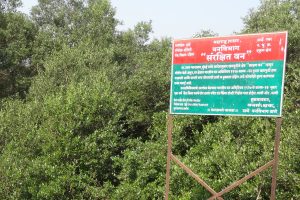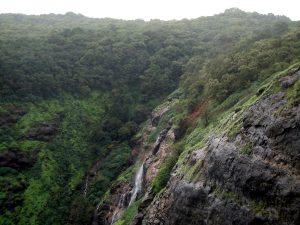MANGROVE WETLAND CENTRE
CAT spearheaded in proposing a Mangrove Wetland Centre in Mumbai. A landmark partnership between the Conservation Action Trust (CAT) and HSBC has enabled CAT to complete first phase of this project.
The project has been developed to celebrate the importance of Mumbai’s valuable mangrove forests and give members of the public an opportunity to explore these amazing eco-systems. Mumbai’s Mangrove Wetland Centre (MWC) will be the first of its kind in India and aims to protect mangroves by building a better understanding of just how essential these plants are in protecting not only Mumbai’s coastlines, but coastlines all around India and the world.
MANGROVE WETLAND CENTER - AN OVERVIEW
Mumbai’s Mangrove Wetland Centre (MWC) will be the first of its kind in India and aims to protect mangroves by building a better understanding of just how essential these plants are in protecting not only Mumbai’s coastlines, but coastlines all around India and the world.
The Centre will follow the excellent example set by the Mai Po Marshes Wetland Park in Hong Kong and is set to become a leading centre for mangrove and coastal conservation and research. The Centre will offer a truly unique experience and visitors will be able to walk amongst mangrove forests and see first-hand the truly fascinating array of flora and fauna hidden within. Visitors to the Centre will also be able to learn how mangroves can help reduce levels of flooding in Mumbai and find out how we can all work together to ensure that the destruction of mangroves is halted.
As an island city dependent upon mangroves for its survival, Mumbai is the ideal location for such a nationally important project. The Mangrove Wetland Centre project is the product of years of research on the mangroves in Mumbai and once completed it will be an example to emulate along the coasts of India.
CAT is thankful to HSBC for being its key partner during Phase I for this revolutionizing initiative. The signing of an MOU with the Forest Department which gives the project, planned for the western coast of the Thane Creek, full approval is awaited. The introduction of a Wetland Centre in Mumbai will be an example of green governance in a city which is an international economic hub for India. The project will provide employment opportunities for local communities and will firmly put Mumbai on the international conservation map.
CAT & MANGROVES
What Are Mangroves?
Wetlands have immense ecological importance and mangroves are one of the most fascinating wetland plants. Mangroves are particularly important as buffer between the land and the sea. They protect fragile coastlines from erosion, effectively control floods, provide a variety of fish and clean coastal waters.
Mangrove ecosystems are a peculiar habitat covering the transition zones between the tropical land and sea. In the mangrove forests one can see how a tropical rainforest (Jungle) gets transformed into a Mangle (forest in marshes). They grow on clayey soil, which is flat and sloping gently (mudflats), and in the region where tidal action brings in water regularly. Mangroves are found extensively in the estuarine regions where salt water mixes well with the fresh water. Besides estuaries, they also inhabit inter tidal regions of shallow bays and creeks where the environment is conducive for the growth of mangroves.
The Indian mangroves comprise approximately 59 species in 41 genera and 29 families. Of these, 34 species belonging to 25 genera and 21 families are present along west coast. There are basically 6 types of mangrove forests. They are:
- Over wash mangrove forests: These are small islands covered with mangroves that are frequently washed by the tides. The dominant species is Rhizophora or the red mangrove.
- Fringing mangrove forests: These strips of mangroves are found along waterways and are covered by daily tides. The dominant species is red mangrove.
- Riverine mangrove forests: These are luxuriant stands of mangroves along tidal rivers and creek with a good input of fresh water. Often comprises red mangrove, grey mangrove, mangrove apple, etc
- Basin mangrove forests: These are stunted mangroves located in places such as the interior of swamps, often dominated by Avicennia or the Grey mangrove.
- Hammock mangrove forests: Similar to basin mangrove forests but are found in more elevated sites
Scrub mangrove forest: A dwarfed stand of mangroves found on flat coastal fringes.
Mumbai’s Mangroves
Mumbai is a reclaimed mass of islands. As there is little original land and sea from all sides, Mumbai is vulnerable to sea erosion. The only cost effective way to save Mumbai from erosion and delay the impacts of the rising sea level is to protect its mangroves. If given time, the mangroves will not only save the city from erosion but will also slowly create more land by pushing the sea back gently and keep the ill effects of the sea farther away.
Mumbai has gone through many cycles of mangrove deforestation and land reclamation and during this time the mangrove cover of Mumbai has been brought to less than one third of its original amount. However, large continuous areas of mangrove cover are seen today in Mumbai along the Vasai Creek, Thane Creek, Manori and Malad, Mahim – Bandra, Versova, Sewri, Mumbra – Diva and few other places. It is essential these areas are protected from damage.
Around 18 out of the 35 species of true mangroves found in India have been identified along the Maharashtra coast and 13 species of these are found in Mumbai. However, one species that really dominates the Mumbai coastline is Avicennia marina, mainly due to uniformly high salinity across the region.
CAT And Mangroves
Debi Goenka started a humble campaign on saving mangroves at the Rewas Jetty in the Raigad district in 1983. A large tract of mangroves (about 100 hectares) was then being destroyed for industrialisation by reclaiming this “wasteland”. ‘Save Mangroves’ campaign was then taken up by the Bombay Environmental Action Group, which filed various petitions in the Bombay High Court and the Supreme Court of India to protect this important and vulnerable ecosystem in our country. The Conservation Action Trust takes this legacy ahead and spearheads the mangrove conservation programme in Mumbai and the State of Maharashtra.
FAQs
WHAT IS THE MANGROVE WETLAND CENTRE? (MWC)
Mangrove Wetland Centre is a concept developed by Conservation Action Trust (CAT) for Mumbai. CAT is proposing a Wetland Centre in Mumbai along the western coast of the Thane Creek. The proposed wetland centre will be situated at suburbs of Kanjur, Bhandup and Mulund. The proposed centre will come up on the mangroves notified as ‘Protected Forests’ along the Thane Creek.
WHEN WILL THE PROPOSED MANGROVE WETLAND CENTRE BE READY?
We are in the first phase (planning phase) of the project. Towards the end of the planning phase (November 2008), a Master Plan will be submitted to the Government. Upon approval of the same, the second phase of establishment of the Centre will start. The Centre is expected to be completed in 3 years and then, the third phase will start where actual education and research plan will be implemented. .
HOW MANY PEOPLE ARE EXPECTED TO VISIT THE MWC?
The MWC is being designed to accommodate about one million people a year.
WHO OWNS MWC?
Forest Department, Government of Maharashtra is the owner of the land and property of the MWC.
CAN I SEE ANY ENDANGERED ANIMALS AT THE MWC?
MWC is not a zoo or a safari. It may not be possible to view any major or threatened mammal species at the MWC. However, the MWC will have a large number of visiting birds; many of them are rare and threatened species. If lucky, you may see a mongoose or a jackal or a wild boar in the area. MWC will also be a paradise for reptiles.
HOW MUCH OF THE MWC IS OUTDOORS?
About 70% of the learning experiences and interpretation will be outside the Interpretation Centre. About 30% of the exhibits would be indoors.
WILL THE MWC BE OPEN ON A RAINY DAY?
Yes. The MWC will remain open even during the monsoon. However, the boardwalks may remain partially open during heavy showers.
WHAT IS THE AVERAGE YEARLY RAINFALL AT THE MWC?
The average precipitation at Mumbai is 2190 mm (30 year average). The rains start in the first week of June and continue till end of September. July is the month when the city receives maximum rainfall. During the four months of the monsoon there are dry spells of over 15 days.
WHAT IS THE LATITUDE AND LONGITUDE OF THE MWC?
19°08’N
72°57’E
HOW LONG WOULD IT TAKE TO SEE EVERYTHING AT THE MWC?
Visitors can look forward to about 3-6 hours of time at the MWC on any given day.
IS ONE VISIT TO THE MWC SUFFICIENT?
No! The MWC will have different characters for every season and it may take more than one visit to appreciate the MWC at its full potential. Besides, there will be several new components added to the educational programmes and hence MWC could be visited frequently by the schools and educational institutions.
WOULD THERE BE ACCESS FOR PHYSICALLY CHALLENGED PEOPLE?
The MWC will be designed to give free access to people with all kinds of physical disabilities.
WHO WILL GUIDE ME IN THE MWC TO GO THROUGH THE WILDERNESS?
MWC is planning to train and engage local fisher folks to guide the visitors. Besides these community guides, there would be education volunteers and the education staff, who would assist the visitors in interpreting the mangroves and the wetlands.
ARE PETS ALLOWED ON THE MWC GROUNDS?
NO.
WHAT WOULD BE THE MWC HOURS OF OPERATION?
MWC will be open every day of the year from 07:00 a.m to 06:00 p.m.
HOW MUCH WOULD IT COST TO VISIT THE MWC?
We cannot comment on it at this stage. However, we will ensure that the park entry would be affordable to people from all walks of life.
WHO IS FUNDING THIS PROJECT?
HSBC India is the founder sponsor for this project.
WHO WOULD MANAGE MWC ON COMPLETION?
MWC will be managed by an independent Steering Committee appointed as per the clause of the agreement signed between the Government of Maharashtra and CAT. The Steering Committee will have fair representation from the Government and Society.
WHAT KIND OF ACTIVITIES WILL BE UNDERTAKEN AT MWC?
MWC will be running a variety of programmes to inculcate conservation values among the general populace. There will also be celebrations like World Wetland Day, Earth Day, Wildlife Week, etc. MWC will also encourage competitions for various age groups. Apart from this, MWC will also host events to encourage interaction between various groups and NGOs.
WHY SET UP MWC?
Mumbai cannot survive without mangroves. Despite their importance, mangroves are still being neglected by majority of the population. MWC is an effort to reach out to every resident of Mumbai and make them aware. MWC is not just an education hub. It will have a lot of recreational value as well. One can simply visit MWC to de-stress or for fresh air.
HOW DID HSBC GET INVOLVED IN THIS PROJECT?
It is HSBC’s vision to be the world’s leading financial services company. HSBC makes efforts to be the first choice of customers and employees – the best place to bank, and the best place to work. HSBC believes that it can play a role in helping to address the formidable challenges that the society is facing today and make world a better place to live in and in turn make its own business more sustainable. HSBC supports environment conservation and sustainability initiatives in all countries where it operates. HSBC understands that mangroves are a unique ecosystem which need to be conserved and protected for present and future. The Mangrove Wetland Centre eminently proposes to achieve this objective.
HOW IS MWC A UNIQUE EXAMPLE OF PPP (PUBLIC –PRIVATE – PEOPLE PARTNERSHIP)?
For the first time on the west coast of India, an organized effort of bringing public, corporate and government together is being made to protect mangroves. Joint Mangrove Management (JMM) is a concept accepted on the east coast of India which is vulnerable to cyclones and tidal waves. The PPP or JMM approach will actually make the local people responsible for the protection of their own mangroves.



